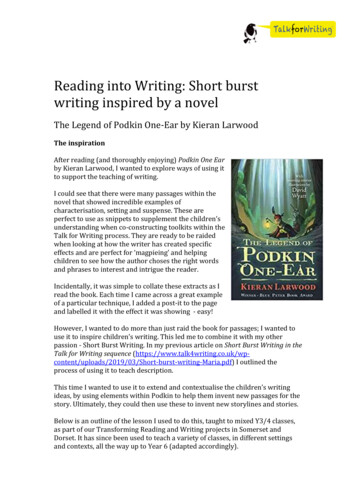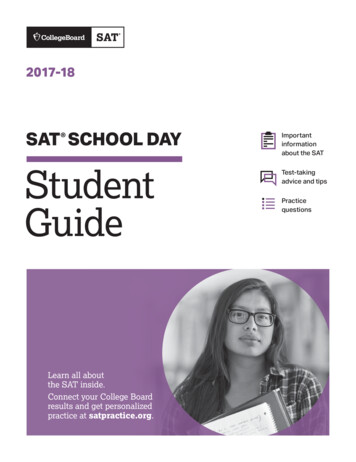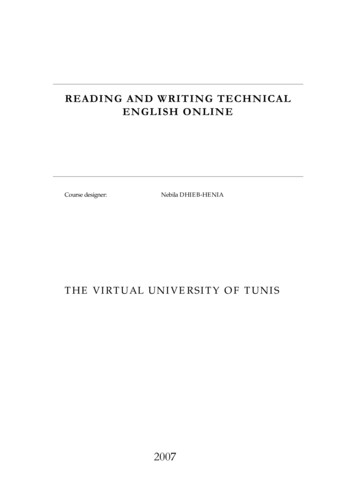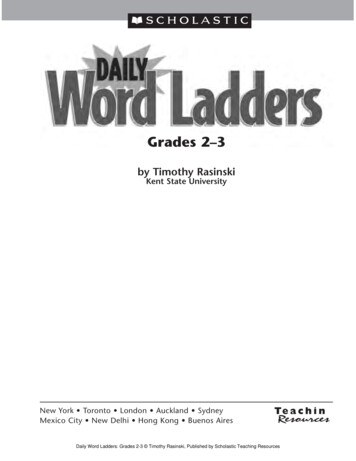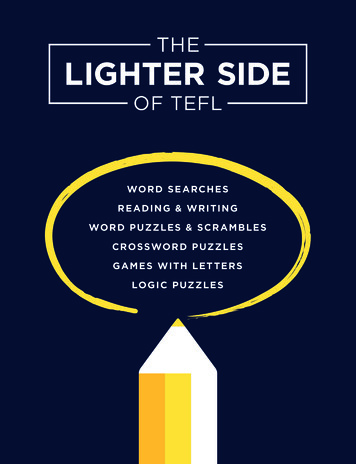
Transcription
WO R D S E ARCH E SR E AD I N G & WR ITI N GWO R D P UZZ LE S & SCR AM B LE SCROSSWO R D P UZZ LE SGAM E S WITH LE T TE R SLOG IC P UZZ LE S
A Teacher’s Resource Book of Fun Activitiesfor Students of English as a Foreign Language 2019 by The Bureau of Educational and Cultural Affairs, Office of English Language Programs.This work is licensed under the Public Domain. To view a copy of this license, ublic-domain/pdm/
The Lighter Side of TEFL 2019 by The Bureau of Educational and Cultural Affairs,Office of English Language Programs.This work is licensed under the Public Domain. To view a copy of this license,visit -domain/pdm/This publication is available free of charge online at: www.americanenglish.state.govOffice of English Language ProgramsBureau of Educational and Cultural AffairsUnited States Department of StateWashington, D.C.americanenglish.state.govThird Edition 2019Second Edition 2010Reprinted in 2005First published by the United States Information Agency in 1994First and Second Editions Compiled by Elizabeth BallThird Edition Compiled by Amy HannaEditor of First Edition: Thomas KralOriginal Layout and Design: Cynthia MaleckiThird Edition Cover Art: Fathom Creative, Inc.
Dedicated toAnne Covell Newton“A little of this and little of that(A balanced mixture of lean and fat)Adds Spice to the pudding; it cannot hurt,And it brings to the reader his just dessert.”**From the first Lighter Side Page published in the English Teaching Forum, January 1976
This third edition of The Lighter Side of TEFL contains activities mainlytaken from English Teaching Forum from 2004 to the present. A few puzzlesthat were published prior to 2004 are included. The puzzles are groupedinto categories by type. The categories also progress from letter- and word-basedactivities to more complex exercises involving reading and writing skills.introductionThe purpose of The Lighter Side of TEFL has always been to make learningEnglish fun. These puzzles help students develop vocabulary and practicethinking critically. Listening, speaking, reading, and writing may be used tosolve the puzzles, but the goal of each activity is to inspire students to seethat communicating in English can be an enjoyable, and even lighthearted,experience.Each of the puzzles in this book would be an excellent warm-up activity at thebeginning of class, or a great wrap-up activity at the end. The puzzles are shortand do not require any additional materials. These activities are best completedin pairs or small groups so that different perspectives can be utilized—andenjoyment can be shared! After completing the puzzles, discuss the answers as aclass using the solutions found in the back of the book.The Lighter Side of TEFL is a resource for teachers, who may reproduce individualpages for use in their classrooms. The puzzles in this edition are intended tobe used as supplemental material—warm-up games, group work, wrap-upactivities—not as a textbook for students to complete during a course.
1table of contentssection 1games withletters12section 2word searches23section 3scrambles34section 4crosswordpuzzles
42section 5word games52section 6reading writing67section 7logic puzzles77answer key94puzzle credits
games with letterssection 1The puzzles in this portion of the book must be completed by filling inletters that are missing from words. These activities help students practiceparts of speech, spelling, sound/symbol correspondence, and vocabulary.For beginner students, an activity that provides practice with letter identificationand the order of the English alphabet is included.Teaching Techniques. To motivate students, these activities can be completedin small groups or teams to see who can finish first or which team can getthe most correct answers. Use the puzzles about dog tricks, animal sounds,motorcycles, and gardens to introduce or review vocabulary related to thosetopics. Give students one of the puzzles prior to teaching about the topic toassess background knowledge, and then have learners complete it again afterteaching. The puzzles Fishy Fun and Silent Letters can be used to teach specificpronunciation skills and spelling patterns. What’s Missing? is excellent forreviewing vowel sounds and spelling patterns. The activity can be scaffolded byreading the words aloud and asking students to listen for the missing vowels.
2Chicago Word TrainFill in the spaces with the letters of the 24 words defined by the clues below.The words are linked like cars in a train; the last letter of one word is the firstletter of the next word. —fountain1.noun. A structure or artistic object that sprays water2.noun. A daily publication of news3.noun. Part of the track that a train runs on4.noun. A body of water surrounded by land5.verb. To consume food6.noun. A tall building or structure7.noun. A long, flowing body of water8.noun. A cement or dirt path for vehicles9.adjective. Moistn10. noun. Baked dough topped with tomato sauce and cheese11. noun. Tank that holds water; home for fish12. noun. Institution that displays art to the public13. noun. Sounds made by voices or instruments14. verb. To trim or cut15. noun. Wooden structure where ships dock16. noun. Top covering of a house or building17. noun. Nourishment consumed daily18. verb. To move in rhythm with music19. noun. Opposite direction of west20. noun. A narrow path21. noun. Circular route22. noun. Authority or control23. noun. Objects arranged in an orderly linew24. adjective. Blustery or breezywindy
3I am the largest of the land mammals. I live in the forests andsavannas of Africa, India, and Southeast Asia. Who am I?To answer the question connect the letters of the alphabet inorder (A, B, C ), first the capital letters, then the small letters.
4W H — T'S M — S S — N G ?Below is a list of activities that might be part of an English Clubmeeting. However, the vowels are missing from the activities. Your jobis to fill in the missing letters to complete the list.For example, you would complete “S K T S” by filling in the blank with an I to spell skits.Now see if you can fill in the letters below.1.S NG NGS NGS2.M V3.B K4.D B T5.R L6.D SC SS NG7.P H T8.G M S9.C NV R S T N10.C FF11.T R N S L T N12.W T C H N GTVS H W S13.L ST N N GTP D C ST S14.L CT N GN G HTCL BP L Y SC R R NTV NT SC NT STP R CT CBR KCL BFF C RS
5PDog Trickseople often teach their dogs to do a “trick” in response to a command. Fill in the spaces below withcommands that someone might give to a dog (this one is named Fido). Use the letters in Fido’s fooddish to spell the tricks; cross off the letters as you use them. The frst command has been done for you.1. Tell your dog to bark.“Fido, S P E A K .”2. Tell your dog to take a seat.“Fido,.”3. Tell your dog to put its paw in your hand; then move it up and down.“Fido,.”4. Tell your dog to move to a sleeping position on the floor.“Fido,.”5. Tell your dog to move from its stomach to its back while lying down.“Fido,.”6. Tell your dog to run after a ball, pick it up, and bring it back to you.“Fido,.”7. Tell your dog to lie down and pretend it is no longer living.“Fido,.”8. Give your dog a reward!“Fido, good job! Here’s aIMAGES SHUTTERSTOCK.COM!”
6FAnimal Soundsind the letters indicated by the clues. Next, write those letters in the numbered blanks in theMatching section to spell animal sounds. Then match the sounds with the animals that make them.CLUES12345678910111213141516A First letter of the word for living creatures ( A N I M A L S ) Last letter of a place where crops are grown and animals are raised ( ) First letter of an animal that swims, such as salmon or cod ( ) First letter of the things that hens lay ( ) First letter of an animal whose young are called “kids” ( ) Second letter of a farm animal that is pink ( ) First letter of the word for “baby cat” ( ) First letter of an animal that rhymes with mama ( ) Last letter of a building that animals live in on a farm ( ) Second letter of an animal that is known for providing milk ( ) First letter of the head of a bee colony ( ) Second letter of the word for “baby dog” ( ) First letter of a liquid that animals drink ( ) First letter of the word for a young rabbit ( ) First letter of an animal that can live in a house or barn and eats mice ( ) First letter of an animal that can pull carts and race ( )MATCHINGAnimal 115724101314A1A1HORSECATDOG1310103SHEEP946516COW
7Shop TalkShop talk is a phrase used to describe conversation related to someone’s work.Shop is also a short term for a mechanic’s shop, a place to get your car or motorcycle fixed.Read the questions below. Each answer is a motorcycle part, and each answer fts into one set ofblanks on the right. Fill in the letters to complete each answer and draw a line from each questionto the matching answer. (The frst one has been done for you.) If you need help, at the bottom youwill fnd a picture of each part.1. What part of the motorcycle showsyou how fast you are going?2. What do you use to shift gears?3. What do you wear to protect your head?4. What holds the motorcycle up whenyou are not riding it?5. What do you look in to see behind you?6. What do you put fuel in?7. What stops the motorcycle?8. What do you hold onto to steer the motorcycle?9. What gives the bike power?10. What do you use to turn on the motorcycle?ALL IMAGES SHUTTERSTOCK.COM
8TenpinsTen is a signifcant number in bowling: The goal is to knock down all ten pins, and a game ofbowling has ten frames. In each of the ten bowling pins is a word that contains the letters t-e-n(as in brighten and intense). Use the clues to complete the t-e-n words.1. go to (a class or a meeting)7. frequently2. Table of8. make believe3. past participle of eat9. bad (describing food you can nolonger eat)4. scare5. a baby cat6. pay attention to a sound10. “Please give your answer in acomplete .”
9Jumble GardenUse the letters provided to make words based on the definitions. If aletter appears only once, you cannot use it more than once in youranswer. In each set, one answer will use all the letters.ExampleA T L P Nant a small black insectpan something you cook fresh vegetables inplant something green that grows out of the earthD N R E A G R E1.2.3.4.the color of a ripe tomatothe color associated with naturea place with dirt, owers, vegetables, and other plantsa person who plants owers, vegetables, andother plantsN W R E I F G O L5.6.7.8.a line of plants in a gardenthe past tense of growthe blossom of a plantthe blossoming of a plantV L O H E S D E9.10.11.12.plant13.14.a tool used to break up dirtwhat you dig in the ground to put a plant ina tube used to spray watera small thing you put in the ground that will become aa tool used to digused a tool to dig
10Fishy FunSay these five times fast!Below are five incomplete tongue twisters. In each one, you can complete all thewords by adding the same letter. Add the missing letters, then practice sayingthe tongue twisters as fast as you can.1. he aw even wimming hrimp.2. ive at lat ish lapped.3. liver rdered ily range ysters.4. rincess atty’s retty ond is erfect.5. hris aught old, rusty lams.MatchingIn the column on the left, the first letter and last letter of each word are missing.Fill in the blanks to complete each word. Then match the word with its definitionin the right-hand column.1. anoa. to get a ÿsh out of the water2. ob. a group of ÿsh swimming together3. atcc. a large body of saltwater4. aid. a large ÿsh with sharp teeth5. chooe. a long, slender boat6. ceaf. it prevents the boat from oating away7. akg. food (or other items) used to attract ÿsh8. ooh. a large body of freshwater9. hari. a long, thin pole used for ÿshing10. nchoj. a small, curved piece of metal at the endof a ÿshing line
11Silent LettersThe letter ! in the word !"# #"% is silent; that is, it is not pronounced. Silentletters appear in the spelling of many English words. In the conversationbelow between two &"%'#()* ,-.)#"%*/0123 readers, there are blanks for somewords that contain silent letters. Can you fill in the blanks with letters to spell theappropriate words? In each missing word, the silent letter is given to you. (Forexample, in “Don’t forget to B your hair,” the missing word would be .034*—the 4 is silent.) Numbers in brackets, such as [1] and [2], at the end of a sentencecorrespond with the answers you will find in the Answer Key.Forum Reader A: H are you doing? [1]Forum Reader B: I’m knitting a sweater.A: That looks like fun.B: So, do you like to knit?A: I’m not sure. To tell you the truth, I don’t K how. [2]B: I can teach you. All you have to do is watch me and T to mydirections. I’ll tell you what to do. [3]A: Thanks! I’d like to learn. I don’t have much time now, U G H. Maybesome other time. [4]B: Why don’t you come to my knitting circle? It’s a club I’m in. We get together toknit and chat for a few H . It’s fun! [5]A: But I’m not a member of your knitting circle.B: No problem! You can come as my U . Everyone will welcome you. [6]A: It sounds interesting. When do you meet?B: We meet W times a week, on Mondays and D . [7], [8]A: That sounds great! Thank you! Oh, by the way, W is the sweater for? [9]B: It’s for a close I of mine. She lives in a G country, halfwayaround the world, so I’ll have to send it to her. In fact, she lives on anS , surrounded by water. [10], [11], [12]A: Is the weather cold there?B: Not in the summer. But it’s cool in the N and winter. [13]A: Well, I hope she likes the sweater.B: So do I. And I hope it ÿts her, too. I’m a little bit afraid it’s going to be theW size! [14]
section 2Wword searchesord searches may seem simple, but these puzzles can actually be usedfor more than just finding words. The word searches included herecan be used to introduce or review vocabulary, practice synonyms andantonyms, and familiarize students with terms related to poetry.Teaching Techniques. The puzzles related to specific topics can be assignedbefore beginning a unit as a way to introduce new vocabulary to students. Havelearners work in pairs to locate all of the words. Once all of the words are found,have students write down what they think each word means or describes. Afterteaching the unit/lessons related to the topic, revisit the word search and havestudents write down the meaning of each word based on what they have learned.Compare the ideas to see what students remember from the lessons. As anextension, have students write sentences or a story with blanks where the wordsfrom the puzzle would go. Have partners exchange sentences/stories and fill inthe blanks with the words from the puzzle.
13Winter Sports Word SearchFigure out the answer to each numbered clue below. Then search for and circlethose answers in the grid. Words may be printed vertically, horizontally,diagonally, or even backwards. All answers are related to winter sports, and thenumber of letters in each answer is indicated.1.2.3.4.5.6.7.8.9.10.11.12.13.14.15.This is the color of snow.Many winter athletes wear these to keep their hands warm.In this team sport, players on skates try to score goals with a puck.One of the most popular winter sports is figure .There are many variations of this sport, in which athletes race down snow-coveredmountains.This country was the host of the 2010 Winter Olympic Games.In this sport, athletes ride boards, like wide skis, on the snow.The Olympic Games were held in the same year as the Summer Olympic Gamesuntil 1994.Skaters compete on this surface.Children love to sit on these and ride down snow-covered hills.The Winter Olympic Games are held every years.To keep their feet warm and dry, many athletes wear these in the snow.These are higher than hills, and skiers love to glide down their sides.Snowboarders (and bobsledders) wear these to protect their heads.Skiers compete on this surface.
14New York City Word SearchFigure out the answer to each of the clues below. Then search for and circlethose answers in the grid. Words may be printed vertically, horizontally,diagonally, or even . is another name for the Theatre District in midtown Manhattan.2. In 1609, an English explorer sailed up this body of water now named after him. (2 words)3. is a neighborhood in New York City known as a place of avant-garde art andprogressive politics.4. With the opening of the in 1825, New York became the premier American port on theAtlantic coast.5. The headquarters of the is international territory owned by all membercountries.6. The was a gift from France to the United States, representing the friendshipformed between these two countries during the American Revolution.7. This building is shaped like a spiral, wider at the top than the bottom. (2 words)8. Each year millions of people visit this location to enjoy the lakes, play sports, visit the zoo, or see free playsand concerts. (2 words)9. It is said that if you have performed at , you have reached the top of your musicalcareer.10. Until 1954, this was the tallest building in the world. Today it is one of the most famous tourist attractionsin New York City. (3 words)11. Opened in 1883, the joined Manhattan to Brooklyn and was considered one ofthe greatest engineering feats of its time.12. During the 1920s and 1930s, this neighborhood was home to many famous African-American writers andmusicians, such as Langston Hughes and Duke Ellington. (1 word)
15Weather Word SearchFind the weather words listed below. When you find a word inthe puzzle, circle it. Words can appear vertically, horizontally,diagonally, or even nyTemperatureUmbrellaWarmWeatherWindWindy
16Poetry Word SearchBelow is a list of several poetry terms. See if you can find themin the word search. The terms may be printed vertically, horizontally, or ickPersonification RhymeVerse
17HOME ON THE RANGEAN EXCERPT FROM IF YOU FEEL LIKE SINGING BY ALICE H. OSMAN AND JEAN MCCONOCHIEThe origin of this song, as of many otherfolksongs, is uncertain.We know that itwas sung in Texas as early as 1867. We alsoknow that a set of words was published in1873 by a pioneer doctor, Brewster M. Higley,who had moved from Ohio to Kansas (somesaid he moved to escape his bad-temperedwife).The music has been attributed to DanielE. Kelley, a musician and entertainer who hadmoved to Kansas from Rhode Island. Honoring these two men, Kansas adopted Home onthe Range as its state song in 1947.The Homestead Law of 1862 encouragedthe westward movement that brought Higleyand Kelley to Kansas. Under this law, a settlercould become the owner of 160 acres ofland after paying an 18 fee and farming theland for five years. This distribution of government land soon brought an end to theopen range; by 1885, railroad tracks andbarbed wire fences had divided the land.By the turn of the century, most of the buffalo, deer, and antelope had been killed. Buffalo can now be found only in zoos and onsmall private ranches.The deer and antelopeherds have grown in recent years; they present a wildlife conservation problem becausethere isn’t enough open land to supportthem. The range celebrated in this song—thousands of miles of unfenced grasslandbetween the Mississippi River and the RockyMountains—now exists only in OWORDERMQTUPEECOURAGEA WORD SEARCH PUZZLEFind the following words in the word searchpuzzle. When you find a word, circle it. Wordscan appear vertically, horizontally, diagonally,or even backwards.allantelopearecourage (from eword
18U RBAN R ENEWALA WORD S EARCH P UZZLEFind the following words in the word search puzzle. When you find a word, circle it. Wordscan appear vertically, horizontally, diagonally, or even choolssidewalkskyscraperstreetszoning
19POSTC ARDS WORD SEARCHT S L G W S R A B H O R SX E S F F FI Q III M A G E M E T B P J F L C O P QT E E L L K U H E V G K SI A O E T M KK J G E R U T J S S N N X C I H R H M G G A H S M W V O A IX N Z J R Y D Q U T K T I P I R X D E T K M S M C L D H T REXMPOCDWILPFWFVPZNOVPWDZMITKUAGBFind the following words in the word search puzzle. When you finda word, circle it. Words can appear vertically, horizontally, diagonallyor even GXVHSBDLHTZDZQIQMRMNIORRMWVWBOAWXBDL
20Antonym Word SearchBelow are eight common pairs of antonyms. However, only the firstletter of each word is given. First, think of the antonyms and write thewords in the blanks—one letter per blank. Then find all 16 words in theWord Search. Circle the words as you find them. The words can be foundwritten horizontally, vertically, diagonally, forward, or backward. The firstword has been filled in and circled for you.AntonymAntonymYESSUGTNRHNGDBFDLLWORD IASIUP
21Synonym and Antonym Word Search 1Think of a synonym and antonym for each of the feelings on the left.Write the words in the blanks—one letter per blank. The first letterof each word is shown. Then find the feelings, synonyms, and antonymsin the Word Search. Circle the words as you find them. The words can befound written forward, backward, horizontally, vertically, or diagonally.The first synonym has been filled in and circled for dAntonymASBCOBLSynonymSLEEPYJEFTAMWORD BEDJRAMYAHRROAYZALOESAGURGFMVJGRIONFEESLEEPYPPAHDR
22Synonym and AntonymWord Search 2Think of a synonym and antonym for each of the adjectives on the left.Write the words in the blanks—one letter per blank. The first letter ofeach word is shown. Then find the adjectives, synonyms, and antonymsin the Word Search. Circle the words as you find them. The words can befound written horizontally, vertically, diagonally, forward, or backward.The first synonym has been filled in and circled for ndbigILLSWCQNLHHPWSMLWORD BCSALIUYIERRPKATTSIECINUOUFMHACTHONBOTSIYKKINDHARD
section 3Scramble activities can be used to practice vocabulary and spelling. Thescrambles in this section require students to rearrange letters to correctlyspell words related to various topics including animals, maps, classroomobjects, and more. In some cases, there are clues to help students figure out thescrambled word, but in others they must think about the topic of the puzzle toguess the word.scramblesTeaching Techniques. Students can be divided into small groups or teamsand compete to be the first to finish a scramble activity. The puzzles can also besplit up to use as a warm-up at the beginning of class. One or two of the clues/scrambled words from a puzzle can be copied onto the board for students tocomplete when they come into class. A brief discussion of answers can followto get students ready to learn. As an extension, learners can use the format ofthese puzzles to create their own clues with scrambled words as a way to reviewconcepts and vocabulary studied in class.
24Coin TossUnscramble the set of letters next to each clue to find the answer.Example: These facilities are set up to test the purity of precious metals.Answer: assay offices1. The U.S. coin worth 25 cents is called a .2. The U.S. was the first federal building constructed under the U.S. Constitution.3. Pennies are this color.SSYAA FCSFIOEEARRQTUIMTNPRCOPE4. As a symbol of the United States, this bird appearson all coins in use.EGEAL5. This president was the first to be pictured on aU.S. coin.NLCNIOL6. Only can authorize changing a coin’s designmore than once every 25 years.RGSNCOES7. This is the fourth step in creating coins.NITKSGRI8. Hoping to make a profit, some people collectcoins as an .MTNSETIVEN9. Both the dollar coin and the coin arerarely used.FHAL LADORL10. Children use coins in tabletop games such as.NNYEP KHYOCE11. This mint was established in 1937 to store silverbullion.STWE INTOP12. This law in 1792 created the first U.S. monetarysystem.ANOIECG CTA13. Banks maintain monetary reserves andissue bank notes.ELERDFA REREVES14. Special coins designed to honor a person, place,or event are called .AMOOMERMVITCE15. is the study or collecting of coins.MINMITUCSSA
25Animal Crazy QuiltStep 1. Unscramble the names of the animals. Then place each of theletters, in order, in the “quilt” box below. Place one letter in each boxworking across from left to right. To get you started, the first animalname has been completed.1. ERED D E E R2. ATR4. GDO O5. ABRE B 6. GPIG7. TAN8. ELETATE10. OILN I 11. OWC ODEOAE3. ELAS A9. ATC12. FLWO WTRABGEITOWStep 2. Place the circled letters, in order, into the spaces below tolearn the name of the fastest animal in the world. The first letterfrom the word deer has been placed for you.Which animal is the fastest in the world?This bird can fly at over 200 miles per hour, making it the fastestanimal in the world:P E F N
26Fair FindsBelow is a scrambled list of animals and foods commonly foundat state and county fairs. Unscramble each word, placing oneletter in each blank. To help you, some letters have been placedin the correct positions.1. ipg2. wco3. cukd4. atog5. keaca6. nocrc7. srohe8. tapoott9. teutlecu10. arcpitoi11. umppiknm12. uahqssq13. plaep ipep i14. recyrh iper e15. conott dncayt c16. mewatlronew n
27What’s the Connection?Unscramble the letters in the Scrambled Words to form words that fit theClues, then write the words in the blanks in the Answers column. Lookat the words you are writing and see if you can figure out what they have incommon. If you can, you will be able to answer the Question at the bottom ofthe page. (Tip: After you find some of the answers, try to discover what theyhave in common. That might help you find the rest of the answers.)Scrambled Answers1. A unit of measurement2. A kind of tree3. A young cow4. It gets hammered5. The end of a river6. The leader of a group or department7. Part of a watch or clock8. Part of a journey9. Give weapons to10. The main part of somethingQuestionWhat do the words you wrote have in common?They are of the .
28Mountain ClimbingIn this puzzle, you work from the bottom to the top—as if you are climbing amountain. Climbing a mountain is not easy. Some people reach the top, but otherssee how hard the climb is and go back down to the bottom. These people mayneed encouragement to continue climbing. Your job is to unscramble the wordsto fill in the blanks in the Words of Encouragement sentences at the bottom of thepage. Write those words in the spaces beside the mountain. Then take the letters incircles and squares, unscramble them, and form the Final Message.!Final Message:!8.7.6.5.4.3.2.1.Words of Encouragement1. Keep climbing! You are .2. Be . Don’t be afraid to go higher.3. Don’t up!4. That’s it! Keep !5. A word that means difficult and strong is .6.You’re getting closer! Stay .7.You’ve almost reached your .8.You’ve made it to the top! Fantastic !TOSGNRV EA R BVEIGG RT Y N IO G UT HDDEEE TNMRIL GA OTREOFF
29A Maps Mind MapBelow is a mind map about maps. Your job is to fill in the blanks tocomplete the mind map. (A mind map is a graphic organizer that showshow ideas can be connected and grouped together.)Unscramble the Map Words in the column on the left to spell words that are related to maps:there are four directions, four natural features (such as mountains), and five features made by humans(such as streets).Then use those words to fill in the blanks in the Mi
Third Edition 2019 Second Edition 2010 Reprinted in 2005 First published by the United States Information Agency in 1994 First and Second Editions Compiled by Elizabeth Ball Third Edition Compiled by Amy Hanna. Editor of First Edition: Thomas Kral. Original Layout and Design: Cynthia Malecki. Third Edition


